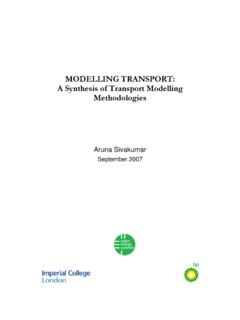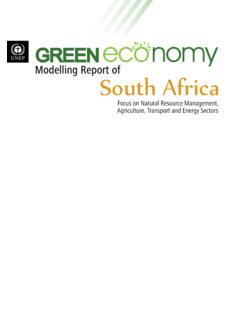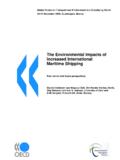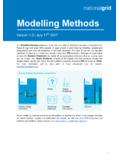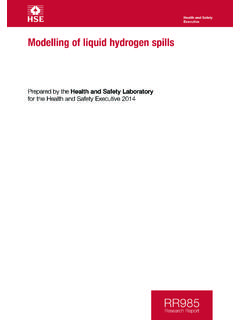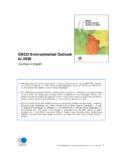Transcription of Power sector modelling: System cost impact of renewables ...
1 Aurora Energy Research Limited. All rights Template 2017aPower sector modelling : System cost impact of renewablesReport for the National Infrastructure Commission 24 May 2018 This report was commissioned as part of the evidence base for the National Infrastructure Assessment. The views expressed and recommendations set out in this report are the authors own and do not necessarily reflect the position of the National Infrastructure Template 2017aReport details and disclaimerGeneralDisclaimerThisdocumenti sprovided asis foryourinformationonlyandnorepresentatio norwarranty,expressorimplied,isgivenbyAu roraEnergyResearchLimited( Aurora ),itsdirectors,employees,agentsoraffilia tes(togetherits Associates )
2 Astoitsaccuracy, ,andacceptnoliabilityfor, ,assumptions, ,anddoesnotintend, ,whichreflectAurora ,thewords"believes","expects","plans","m ay","will","would","could","should","ant icipates","estimates","project","intend" or"outlook" :risksassociatedwithpoliticaleventsinEur opeandelsewhere,contractualrisks,creditw orthinessofcustomers,performanceofsuppli ersandmanagementofplantandpersonnel;risk associatedwithfinancialfactorssuchasvola tilityinexchangerates,increasesininteres trates,restrictionsonaccesstocapital,and swingsinglobalfinancialmarkets;risksasso ciatedwithdomesticandforeigngovernmentre gulation,includingexportcontrolsandecono micsanctions;andotherrisks, (including,butnotlimitedto,thetext,image s,graphicsandillustrations)isthecopyrigh tmaterialofAurora[,unlessotherwisestated ].
3 Nopartofthisdocumentmaybecopied,reproduc ed, byApproved byPower sector modelling : System cost impact of renewables22 May 2018 Oliver Kerr andAnna MacDonald Modeller: Jonathan BlackFelix Chow-Kambitsch Template 2017aList of abbreviationsBEIS Department of Business, Energy and Industrial StrategyCCC Committee on Climate ChangeCCGT Combined Cycle Gas TurbineCCS Carbon Capture and StorageCO2 Carbon dioxideCPS Carbon Price SupportDSR Demand-side ResponseETI Energy Technologies InstituteEV Electric VehiclesGW GigawattkW Kilowatt MtCO2e Metric tons of carbon dioxide equivalentMW MegawattNIA National Infrastructure AssessmentNIC National Infrastructure CommissionOCGT Open Cycle Gas TurbineOfgem Office of Gas and Electricity MarketsRES Renewable energyROCs renewables Obligation CertificatesTWh Terawatt hour4 AER
4 Template 2017aExecutive Summary This study considers the implications for Power sector decarbonization of two different approaches to reducing emissions in the heat sector electrification and hydrogen / greener gas while road transport is assumed to follow an ambitious pathway to electrification Decarbonisation in heat and transport will have implications for electricity demand, the generation mix, and how much CO2the Power sector is able to emit without overshooting the economy-wide emissions limit Regardless of what happens in the rest of the economy, however, we find that almost all Power sector generation will need to be zero carbon by 2050 in order for carbon targets to be metBy 2050, almost all Power sector generation will need to be zero carbon if GB is to meet the ambitious emissions goal mandated by the 2008 Climate Change Act5 AER Template 2017aExecutive Summary We find that a mostly renewable or mostly nuclear System both offer among the most promising pathways to decarbonisation, but the level of ambition required in each case is significant.
5 A high nuclear world would mean building up to 29 GW of nuclear capacity by 2050 equivalent to 9 new Hinkley Point Cs A high renewable world could require up to 26 GW of onshore wind, 68 GW of offshore wind, and 99 GW of solar by 2050 In terms of cost-effectiveness, there is little to choose between a high renewable and high nuclear world, provided there is sufficient flexibility on the System to deal with renewable integration costs. However, we would note that this is highly sensitive to cost assumptions, with renewable costs more likely than nuclear to fall faster than expected With different low-carbon technologies often held up as silver bullet solutions, the fact that both renewables and nuclear can achieve cost-effective decarbonization has the potential to help move the policy discussion beyond technology tribalism.
6 At the same time, both options are likely to present challenges with respect to public acceptance Hybrid renewable and nuclear solutions can also be cost-effective, though they are less appropriate for systems characterized by high peak demand and low flexibility from thermal generation, since this increases renewable integration costsBoth nuclear and renewables can offer cost-effective paths to Power sector decarbonisation6 AER Template 2017aExecutive Summary Pursuing an aggressive renewables policy without adequate support for flexible technologies could increase total System costs by up to 7 billion per year on average, 2030-50 In a flexible System , reaching 70-80% renewable production by 2050 is the cost-optimizing option, with no new nuclear beyond Hinkley Point C needed to meet carbon targets In a less flexible System .
7 More than 40% renewable production by 2050 increases the cost to consumers In a high renewable world, System flexibility is therefore critical to cost-effective decarbonization Cost-effectiveness in a high nuclear world is less reliant on flexibility In a high nuclear world, the importance of interconnectors, batteries, and DSR declinesGovernment policy needs to choose a path and provide the supporting investments needed to enable efficient and cost-effective roll-out7 AER Template 2017aExecutive Summary Policies to support System flexibility are always a low regrets option and are key to enabling a high renewable world It is difficult to reach carbon targets cost-effectively without new nuclear except at very high levels of renewable penetration At the same time, its long lifetime increases the chance that nuclear investments could prove sub-optimal over the long term.
8 Particularly given the potential for rapid renewable and battery cost declines CCS rarely appears to be a cost effective option for reducing Power sector emissionsUncertainty around future technology costs and availability, electricity demand and emissions in heat and transport, and the potential for disruptive change all make the optimal Power sector decarbonization pathway less easy to identify but low regrets options are at hand8 AER Template 2017aExecutive Summary The GW of interconnectors assumed in this study play a big role not just in the provision of flexibility, but also in meeting carbon targets, accounting for up to 15% of generation by 2050.
9 If future policy accounts for the emissions associated with imports rather than assuming them to be carbon-free, GB would have to build a significant amount of additional low carbon generation to meet 2050 carbon targets Network costs are a critical component of whole System costs and could undermine the cost-effectiveness of renewables . More work is needed to understand how they will evolve over time in different future scenarios Breakthrough new technologies are inherently difficult to predict but have the potential to fundamentally disrupt Power System economics A significant change in the relative costs of nuclear and CCS could lead to different outcomes.
10 Though any role for gas CCS is severely limited in a zero carbon Power sectorFurther uncertainties9 AER Template change is needed in the Power sector to reach 2050 carbon flexible System with 70-80% renewable production by 2050 delivers lowest total System costs when all low-carbon technologies are allowed to policy or technology pathways can lead to very different outcomes with important lessons for book10193455808210110 AER Template 2017aForeword The National Infrastructure Commission (NIC) has commissioned Aurora Energy Research to model the decarbonisation pathwaysof the Power sector Aurora have been asked to provide an independent study on the cost trade-off between renewables and other low carbon technologies in meeting the UK s carbon targets.









